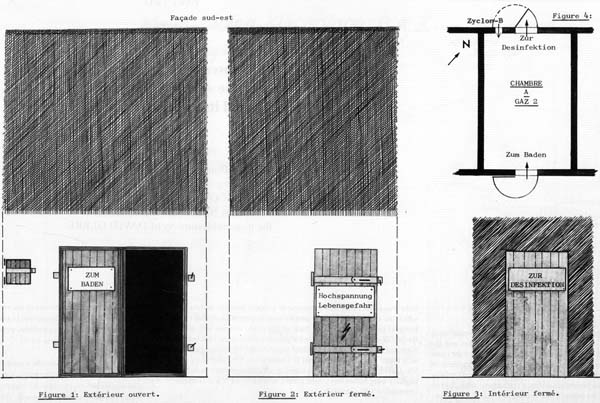In the biggest room there were two little windows
and just one in each of the three others [Document 2: Drawing 2]. These
windows were closed by little wooden doors. Each room had a separate access. On
the entrance door there was a metal sign with the inscription
“Hochspannung Lebensgefar” as already as already mentioned above.
When the door was opened, this sign was invisible but one could see another
“Zum Baden / to the baths” [Document 3: Fig. 1]. The people
entering these rooms to be gassed saw on the exit door the sign with the
inscription “Zur Desinfektion / to disinfection”. It is obvious that
behind this door, there was no disinfection. That was the door through which we
removed the bodies. Each room had its own exit door [Document 3: Figures 3
and 4].
The room I have just been described is faithfully
reproduced in the drawing made by by M. Nosal, an engineer living in Oswiecim.
This cottage was designated Bunker 2 …
After the construction at
Birkenau of Krematorium II, the huts situated next to Bunker 2 were also
dismantled. The pits were filled with earth and the surface was smoothed. The
Bunker itself was kept until the end . It remained unused for a long time and
then was started up again for gassing the Hungarian Jews. They then built new
huts and dug new pits...
Bunker 2 could contain over 2000 people in all
its rooms [see above comments on this point] ...
I would like to point
out that the window fittings of Bunkers 1 and 2 and the doors of these Bunkers
and of Krematoriun IV and V were similar and made of the same
wood…” |
|
| S. Dragon went to live in Israel.
He was a witness at the 25th session of the Dejaco Ertl trial in Vienna on 1st
March 1972. When the hearing was resumed at 1 p.m., he stated that he had
worked in a Krematorium which was a small building with a gas chamber
and stated that “Dieses Gebaüde war aussen weiss / this building was
white on the outside.” He was, in fact, speaking of Bunker 2. S.
Dragon's total confusion between Krematorium I and Bunker 2 caused the hearing
to be suspended so that a Hebrew interpreter could be called. At the 26th
session on 2nd March, he very honestly said “Ich kann mich heute nach 30
Jaren nicht mehr erinnern ... / I can't remember today after 30 years...”
He had also forgotten the drawings (1 and 2) and 2] made in 1945 according to
his indications. The intervening time had done its work, a blessing for the
witness, a disaster for justice and for History. I have added this anecdote to
show the irreplaceable value of early testimony. Afterwards, witnesses
constantly go over the same story, altering it as the years go by. |
| |
 |
|
Document 3:
Drawings by the author to illustrate S. Dragon’s testimony
regarding the notices on the doors
of the gas chambers of Bunker 2.
|
| |
|
|
Translation of
inscriptions: |
|
| |
|
|
|
| |
· |
Façade sud est
/ South-east elevation |
|
| |
Figure
1: |
exterior open —
“TO THE BATHS” |
|
|
|
Figure
2: |
exterior closed
— “High tension - Danger” |
|
| |
Figure
3: |
interior closed
— “TO DISINFECTION” |
|
|
|
Figure
4: |
Chambre à gas
2 / Gas chamber 2 |
|

